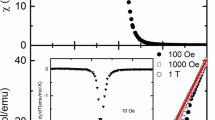Summary
Magnetic and crystallographic properties of solid solutionsxFeTiO3. (1−x) Fe2O3 of hematite (Fe2O3) and ilmenite (FeTiO3), which have rhombohedral crystal structure, are examined in detail for the whole range of 0 ≦x ≦ 1. Samples examined are mineral grains separated out from natural rocks and artificially synthesized ones. The minerals of the hematite-ilmenite series for 0.55<x are ferromagnetic and their Curie-point decreases in proportion to increase inx, becoming 0‡ C aroundx=0.8. Those for 0.55 >x >0 are feeble ferromagnetic, probably being anti-ferromagnetic just same as hematite. Finally probable cause of the ferromagnetism forx>0.55 is briefly discussed. It seems that presence of ferromagnetic ilmenite must always be taken into consideration whenever magnetism of rocks is studied in relation to various geophysical phenomena.
Résumé
On étudie les proprietés magnétiques et cristallographiques des solutions solides rhombohédralesxFeTiO3. (1−x) Fe2O3 de l'hématite (Fe2O3) et de l'ilménite (FeTiO3) pour l'étendue totale de 0 ≦x ≦ 1. Les échantillons examinés sont des minéraux séparés par des grains naturels et des grains artificiellement synthétisés. On montre que les minéraux de la série hématite-ilménite sont ferromagnétiques pourx>0.55 et que leur point de Curie diminue en proportion à l'acroissement de x: il est atteind à 0‡ C quandx est environ 0.8. Les minéraux pour 0.55 >x >0 sont faiblement ferromagnétiques, étant probablement antiferromagnétiques comme l'hématite pure. Finalement, on discute briévement l'origine probable du ferromagnétisme des solutions solides dans l'étenduex>0.55. Il semble que la présence de l'ilménite ferromagnétique doit Être considérée lorsqu'on étudie le magnétisme des roches par rapport aux divers phénomènes géophysiques.
Zusammenfassung
Die magnetischen und krystallographischen Eigenschaften der festen LösungenxFeTiO3. (1−x) Fe2O3 von Hämatit (Fe2O3) und Ilmenit (FeTiO3), die eine rhombohedrale Krystallstruktur haben, wurden im ganzen Bereich von 0 ≦x ≦ 1 ausführlich untersucht. Die untersuchten Proben waren aus Naturgesteinen getrennten sowie aus zusammengesetzten künstlichen Mineralkörner. Die Minerale der Hämatit-Ilmenitschen Reihe von 0.55<x sind ferromagnetisch, und ihr Curie-Punkt nimmt proportional mit der Zunahme vonx ab, und fallsx ungefähr 0.8 erreicht, wird er 0‡ C. Die Minerale von 0.55 >x >0 sind hingegen schwach ferromagnetisch, und vielleicht sind sie genau wie das Hämatit antiferromagnetisch. Zum Schlusse wurde die wahrscheinliche Ursache des Ferromagnetismus im Umfang von x>0.55 kurz besprochen. Es scheint, dass man das Vorhandensein von ferromagnetischem Ilmcnit immer dann in Betracht ziehen muss, wenn man den Gesteinmagnetismus in Bezug auf die verschiedenen geophysikalischen Phänomene untersucht.
Similar content being viewed by others
References
Nagata, T., Akimoto, S. &Uyeda, S.: Journ. Geomag. Geoelec., Vol. 5, 168 (1953).
Nagata, T., Akimoto, S., &Uyeda, S.: Nature, Vol. 172, 630 (1953).
Akimoto, S.: Journ. Geomag. Geoelec., Vol. 6, 1 (1954).
Akimoto, S.: Jap. Journ. Geophys., Vol. 1, No. 2, 1 (1955).
Ramdohr, P.: Neues Jahrb. Min. Geol., Beil., Vol. 54, 320 (1926).
Posnjak, E. &Barth, T. F. W.: Zeit. f. Kristallographie, Vol. 88, 265, 271 (1934).
Chevallier, R. &Mathieu, S.: Ann. de Phys., Vol. 18, 258 (1943).
Roquet, J.: C. R. Acad. Sci., Paris, Vol. 224, 1418 (1947).
Chevallier, R.: J. Phys. Radium, Vol. 12, 172 (1951).
Néel, L.: Ann. de Phys., Vol. 4, 249 (1949).
Guillaud: J. Phys. Radium, Vol. 12, 489 (1951).
Néel, L.: Rev. Mod. Phys., Vol. 25, 58 (1953).
Chevallier, R.: Bull. Soc. Chim. Fr., Vol. 20, 973 (1953).
Chevallier, R., Mathieu, S. &Vincent, E. A.: Geochim. Cosmochim. Acta, Vol. 6, 27 (1954).
Pouillard, E.: Ann. Chimie, Vol. 5, 164 (1950).
Chevallier, R., Bolfa J. &Mathieu, S.: Bull. Soc. Franç. Min. Crist., Vol. 78, 307, 365 (1955).
Nicholls, G. D.: Phil. Mag. Suppl., Vol. 4, 113 (1955).
Néel, L.: Phil. Mag. Suppl., Vol. 4, 191 (1955).
Li, V. Y., Private communication.
Dana,System of Mineralogy, Vol. 1, 7th ed. (1946); A.S.T.M. index card 3-0374(1950).
Michel, A.: Ann. de Chimie, 8, 317 (1937).
Kume S.: Proc. Japan Acad., Vol. 31, 709 (1955).
Shull, C. G., Strauser, W. A. &Wollan, E. O.: Phys. Rev., Vol. 83, 333 (1955).
Uyeda, S.: Journ. Geomag. Geoelec, Vol. 7, 9 (1955).
Author information
Authors and Affiliations
Rights and permissions
About this article
Cite this article
Nagata, T., Akimoto, S. Magnetic properties of ferromagnetic ilmenites. Geofisica Pura e Applicata 34, 36–50 (1956). https://doi.org/10.1007/BF02122815
Received:
Issue Date:
DOI: https://doi.org/10.1007/BF02122815



